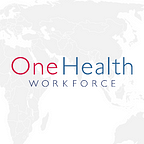Engaging Ugandan university students in infectious disease outbreak response activities
One Health Workforce Key Findings
In the event of an emergency, do you know how you would react?
In many professions, emergencies are inherent and routine aspects of everyday work. Firefighters, emergency department medical providers, army service members, and other first responders are a few of the professions where staff are trained to work effectively and efficiently in tense and chaotic environments. Trainees in these fields gain skills and competencies in primarily two learning environments: simulation scenarios and real-world practice. Both approaches to student training have been associated with positive outcomes.¹²³⁴ Many other disciplines which handle emergencies less routinely, such as laboratory science and public health, might use simulation-based models to train students, but often don’t have the opportunity to engage students during actual emergencies.
The One Health Institute (OHI) at Makerere University in Uganda recognized that students in medical, veterinary, environmental health, and other disciplines often lack exposure to infectious disease outbreaks during their education, and as a result, are underprepared as professionals when these events arise. In response, OHI developed a partnership with the Uganda Ministry of Health (MoH) to which provides opportunities for undergraduate and graduate students to participate alongside government, community, and international health experts during infectious disease outbreaks.
OHI receives support from the USAID-funded One Health Workforce (OHW) project through the One Health Central and Eastern Africa (OHCEA) university network. To date, they have supported 74 OHI students from multiple disciplines including medicine, veterinary medicine, environmental health, engineering, and economics to participate in over 14 different outbreak response investigations across Uganda. Student teams have participated in outbreak investigations addressing avian influenza virus, Ebola virus, Rift Valley fever virus, and Crimean-Congo hemorrhagic fever virus, among others.
In July 2019, OHCEA’s monitoring & evaluation (M&E) team, along with partners from Tufts University and the University of Minnesota, conducted an evaluation of student involvement in outbreak response activities to understand the value of these experiences for students, faculty, and affected communities. Key findings from this evaluation are discussed below, and the full report can be viewed here.
Participating in outbreak investigations provides a valuable opportunity for students to apply knowledge from didactic learning to complex real-world contexts.
These experiences enable students to address real-world challenges and appreciate the environment in which health workers operate. Outbreak investigations are often fast-paced and can be chaotic. Students get to experience this first hand, which may better prepare them for disease investigations as future One Health professionals.
Working alongside individuals from different disciplines and sectors fosters professional relationships, which enables effective coordination when emergencies occur.
Outbreak investigations require coordination between multiple stakeholders involved in the response. The multi-disciplinary composition of student teams allows students to learn from each other and appreciate the unique knowledge and perspectives that each offers, while furthering their understanding of their own roles within a multi-sectoral and multi-disciplinary outbreak response team. This experience also provides an opportunity for students to form professional relationships with health professionals from different disciplinary and institutional backgrounds, which can enable effective communication and coordination during future health emergencies.
Students provide critical support to surveillance and investigation efforts in resource-constrained environments prone to experiencing persistent human resource gaps during outbreaks.
Though the primary focus is student learning, students engaged in outbreak investigations fill important workforce capacity gaps in resource-constrained environments that also happen to be hotspots for disease outbreaks. In communities facing a shortage of qualified professionals able to respond during infectious disease emergencies, students can provide stopgap support in the form of report writing, contact tracing, community sensitization, and transporting supplies, among other activities.
More research and evaluation should be done to understand the longer-term effects for students, communities, and the one health workforce broadly.
Makerere University’s One Health Institute is a leader within the OHCEA network for engaging students in applied and meaningful learning through participation in various outbreak response activities. We hope that their experience developing and implementing this program offers an example and insights for other universities interested in engaging students in community-based learning experiences during infectious disease outbreaks. We hope to be able to track the longer-term impact of this program as well as learn and share how other universities across Africa and around the world are engaging students in similar types of activities.
About the Author
Jonathon D Gass, Jr., MPH is a Monitoring & Evaluation Specialist for the USAID One Health Workforce project and is based at the Cummings School of Veterinary Medicine at Tufts University. Jon’s work focuses on measuring the effectiveness of workforce development and laboratory biorisk management activities in Southeast Asia and Africa.
The author wishes to acknowledge the contributions of the One Health Workforce/OHCEA M&E and communications teams and OHCEA-Uganda staff which made this evaluation and publication possible.
¹Lateef, F. (2010). Simulation-based learning: Just like the real thing. Journal of Emergencies, Trauma and Shock, 3(4), 348. doi:10.4103/0974–2700.70743
²Ruesseler, M., Weinlich, M., Müller, M. P., Byhahn, C., Marzi, I., & Walcher, F. (2010). Simulation training improves ability to manage medical emergencies. Emergency Medicine Journal, 27(10), 734–738.
³Chang, R. S., Hamilton, R. J., & Carter, W. A. (1998). Declining rate of cricothyrotomy in trauma patients with an emergency medicine residency: implications for skills training. Academic Emergency Medicine, 5(3), 247–251.doi:10.1111/j.1553–2712.1998.tb02621
⁴Counselman, F. L., Sanders, A., Slovis, C. M., Danzl, D., Binder, L. S., & Perina, D. G. (2003). The status of bedside ultrasonography training in emergency medicine residency programs. Academic emergency medicine, 10 (1), 37–42. doi:10.1197/aemj.10.1.37
